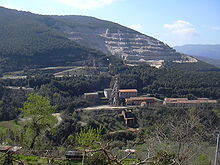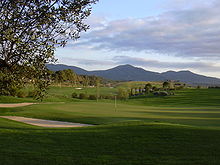Gavorrano
| Gavorrano | ||
|---|---|---|

|
|
|
| Country | Italy | |
| region | Tuscany | |
| province | Grosseto (GR) | |
| Coordinates | 42 ° 56 ' N , 10 ° 55' E | |
| height | 273 m slm | |
| surface | 164.04 km² | |
| Residents | 8,481 (Dec 31, 2019) | |
| Population density | 52 inhabitants / km² | |
| Post Code | 58023 | |
| prefix | 0566 | |
| ISTAT number | 053010 | |
| Popular name | Gavorranesi | |
| Patron saint |
San Giuliano (August 28th) |
|
| Website | Gavorrano | |
 Panorama of Gavorrano |
||
Gavorrano is an Italian municipality with 8,481 inhabitants (as of December 31, 2019) in the province of Grosseto in southern Tuscany .
geography
Gavorrano is located in a hilly landscape about 17 km south of Massa Marittima on the southern edge of the Colline Metallifere and just as far east of Follonica on the Tyrrhenian Sea . The place is located about 25 km northwest of the provincial capital Grosseto and 98 km south of the regional capital Florence in the Maremma and the Colline Metallifere in the climatic classification of Italian communities in zone D, 1 748 GG. The Bruna River flows through the municipality (13 of 41 km). Other important bodies of water in the municipality are the Torrenti Carsia (8 of 17 km in the municipality) and Sovata (14 of 20 km in the municipality).
The districts include Bagno di Gavorrano (40 m, approx. 3000 inhabitants), Caldana (178 m, approx. 1000 inhabitants), Castellaccia (24 m, approx. 80 inhabitants), Filare (100 m, approx. 440 inhabitants), Giuncarico , Grilli (20 m, approx. 270 inhabitants), Potassa (70 m, approx. 160 inhabitants) and Ravi (209 m, approx. 260 inhabitants). The main town itself has about 800 inhabitants.
The neighboring municipalities are Castiglione della Pescaia , Grosseto , Massa Marittima , Roccastrada and Scarlino .
Community structure
In addition to the core town ( capoluogo ), the following districts ( frazioni ) belong to the municipality:
- Bagno di Gavorrano is on the plain. The name comes from a hot spring that no longer exists.
- Caldana is a medieval borgo with a Renaissance church (San Biagio), the facade and interior design ofwhich is attributed tostudents of Michelangelo . Renaissance art is seldom represented in southern Tuscany.
- Castellaccia is on the plain, on the way to Montemassi .
- Filare is located on the hills between Bagno and the center of Gavorrano.
- Giuncarico is a medieval borgo on a hill.
- Grilli is on the plane.
- Potassa is on the plain, near the train station.
- Ravi is also a medieval borgo on a hill.
history
Nothing is known about settlement in antiquity. The first secured dates go back to the 9th century, when Count Alberto di Mangona received the area as a fief from Charlemagne . A document from 1164 mentions a fort with which Frederick I enfeoffed another Albert von Mangona. It is not clear whether it is the same castle that was later held by the Pannocchieschi family of counts .
In 1188 the village of Gavorrano was declared by a bull from Pope Clement III. independent community; ecclesiastically this was subordinate to the Bishop of Grosseto.
In 1278 Count Nello Pannocchieschi becomes mayor ( podestà ) of Gavorrano. About the ancestral seat of this family, the Castello di Pietra (approx. 15 km northeast of Gavorrano between Via Aurelia and Ribolla ), there are some legends, which Dante in section V, 133-136, of the 2nd book Purgatorio ("Purgatory") his Divina Commedia . In a few lines it is indicated that Nello Pannocchieschi, who verifiably married Margarita von Aldobrandeschi when he was already engaged to Pia de 'Tolomei from Siena , killed Pia in his castle:
... ricorditi di me, che son la Pia; Siena mi fé, disfecemi Maremma salsi colui che 'nnanellata pria disposando m'avea con la sua gemma .
("Remember me that I am the Pia. Siena created me, the Maremma destroyed me. The one who first gave me the ring and then promised me marriage with his gemstone knows it").
The truth of this story, the exact circumstances of Pia's death and the motives of the characters are disputed; There is a tradition of jumping (or falling) out of the tower in which she is said to have been locked up and with which Nello may or may not help. The person of the Pia di Tolomei from Siena cannot be unequivocally identified either; The only clues are ceramic objects from the Tolomei house that were found in the castle at the appropriate time. Nevertheless, the lament of Pia from the afterlife, which in Italy belongs to the well-known treasure trove of quotes, describes a murder based on a love drama according to the prevailing opinion.
When the Pannocchieschi left the area in the early 14th century, they ceded the rights to the Free Republic of Massa Marittima . Conquered by Siena in 1335 , the municipality shared the fate of this republic from then on: 1555 conquest by Florence , 1569 incorporation into the Grand Duchy of Tuscany , from 1737 part of the Habsburg family and from 1860 part of the Italian nation-state.
Gavorrano's ascent as the seat of one of the largest pyrite mines in Europe began at the end of the 19th century. At that time, the pyrite was discovered by Francesco Alberti, a former colleague of Garibaldi . Mining began in 1898 and has been in the hands of Montecatini SpA since 1910. The total amount of pyrite mined until the plant closed in 1984 is estimated at 27 million tons.
The Gavorrano mines, which are connected underground with other mines in the Ravi district over 250 km of tunnels, were the most important employer in the region. Tourism has only played a role since the 1990s. The abandoned mining facilities have been prepared as a museum in a Parco Minerario Naturalistico di Gavorrano since 2003 and can be visited with a guide. In the nearby quarry, an open-air theater "Teatro delle Rocce" has been created. Numerous concerts, theater performances, etc. take place here in the summer months.
Attractions
The core town is a medieval borgo high on a hill. From the Piazza della Resistenza there is a broad view of the plain of the district of Bagno di Gavorrano.
- Remnants of walls and some towers have been preserved from the city fortifications.
- One of the medieval alleys with candle arches is named after Count Nello Pannocchieschi.
- At the Palazzo del Podestà an inscription plaque with the well-known lines of Dante reminds of the drama about Nello and Pia in the Castello di Pietra .
- The church, consecrated to the patron saint of the community, dates from the 17th century and replaces an older building; the design of the apse and facade goes back to the beginning of the 19th century. The three-aisled interior houses a Senese Madonna and Child by Giovanni d'Agostino (around 1336, temporarily removed in 2006 during a church renovation).
- On the facade of the town hall, a plaque commemorates Giuseppe Bandi , who was born here on July 15, 1834 (died in Livorno in 1894). He was a man of letters, lawyer and founder of the newspaper Il Telegrafo .
- The Oratorio of the Most Holy Sacrament ( Oratorio del Santissimo Sacramento ), originally dedicated to Saints Cosmas and Damian , dates back to the 14th century; the single-nave building with barrel vaults has a 19th century facade with two small windows and an oculus. No works are kept inside.
- Bruna dam , former dam from the 15th century on the Bruna river.
Local festivals
- Il Salto della Contessa (= Leap of the Countess) on the Sunday following August 6th is a historical festival that deals with the tragic story of Count Nello and Pia. A parade with flag bearers is followed by a horse race ( Palio after the type - but not in size and importance - that of Siena) between the contraden (districts) Tolomei and Pannocchieschi. In addition to the local population, tourists also regularly take part in this spectacle.
- Polenta fair on the last weekend of October in the Bivio Ravi district.
- Autumn festival in October / November in the Caldana district with folkloric performances and tasting stands with local products (porcini mushrooms, wild boar, chestnuts)
Sports
The local soccer club US Gavorrano rose in 2010 to the fourth-class Lega Pro Seconda Divisione . In the 2016/2017 season, she was promoted to the third highest class (Lega Pro). The home games in Lega Pro are played in Grosseto.
tourism
Tourism in the former mining community of Gavorrano, which has no district by the sea, did not start until the end of the 20th century. Apartments and agritourism are on offer for individualists who discover the nature of the hilly landscape, the Maremman gastronomy and wine culture.
The main attraction is the nature park established in 2003 around the abandoned mines ( Parco Minerario Naturalistico di Gavorrano ). There is also an open-air theater within this site with performances in the summer.
Nature and viticulture
Because of their mineral resources, these hills are sometimes called the southern extension of the Colline Metallifere or the Colline Metallifere Grossetane . In the nearby forests there is still an intact animal world (fallow deer, foxes, wild boars). On the agriculturally used areas, olive plantations delimited by cypress hedges alternate with vineyards. South of Gavorrano, section B of the strada del vino of the DOC wine-growing region Monteregio di Massa Marittima runs with over 300 hectares of vineyards, 80% of which is Sangiovese , but also to a lesser extent Trebbiano , Malvasia and Vermentino .
literature
- Giuseppe Guerrini / Amministrazione Provinciale di Grosseto: Torri e Castelli della provincia di Grosseto. Nuova Immagine Edizioni, Siena 1999, ISBN 88-7145-154-6 , pp. 47-53.
- Cristina Gnoni Mavarelli, Maurizio Occhetti: Gavorrano. In: Bruno Santi: Guida Storico-Artistica alla Maremma. Nuova Immagine Edizioni, Siena 1995, ISBN 88-7145-093-0 , pp. 65-71.
- Emanuele Repetti: Dizionario Geografico Fisico Storico della Toscana. ( Online edition of the University of Siena on Gavorrano)
- Bruno Santi (Ed.): I Luoghi della Fede. Grosseto, Massa Marittima e la Maremma. Arnoldo Mondadori Editore , Milan 1999, ISBN 88-04-46786-X , pp. 133-139
- Touring Club Italiano : Toscana. , Milan 2003, ISBN 978-88-365-2767-0 , p. 862 f.
Web links
Individual evidence
- ↑ Statistiche demografiche ISTAT. Monthly population statistics of the Istituto Nazionale di Statistica , as of December 31 of 2019.
- ↑ Official website of CONFEDILIZIA - Confederazione Italiana Proprietà Edilizia on the climatic classification of the municipalities of the Tuscany region, accessed on June 9, 2012 (Italian) ( Memento of the original from March 4, 2016 in the Internet Archive ) Info: The archive link was inserted automatically and still Not checked. Please check the original and archive link according to the instructions and then remove this notice.
- ↑ Official website of the Sistema Informativo Ambientale della Regione Toscana (SIRA) on the rivers in the municipality of Gavorrano , accessed on April 8, 2015 (Italian)
- ^ Official website of the ISTAT ( Istituto Nazionale di Statistica ) on the 2001 population figures in the province of Grosseto, accessed on April 8, 2015 (Italian)






